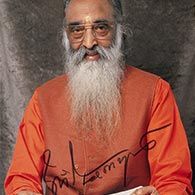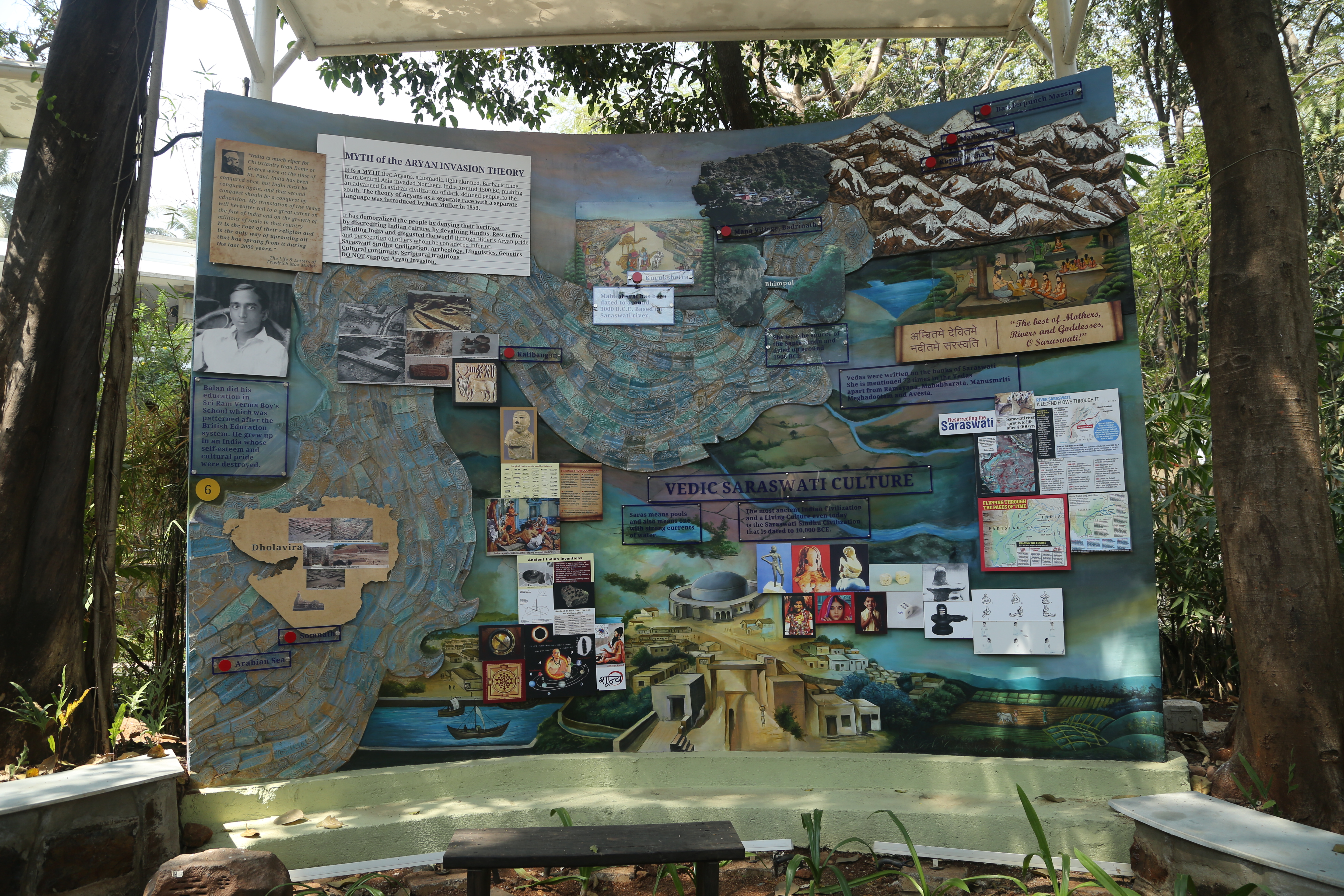What are our cultural roots? Vedic culture is said to have flourished on the banks of the river Sarasvati. Using landsat images, radar imagery, carbon dating etc., the route of Sarasvati River is mapped and dated to 10,000 BCE. The most ancient Indian Civilization and a Living Culture even today is the Vedic Sarasvati-Sindhu Civilization. Indus Valley Civilisation is just a part of this mighty civilization.
Mother Sarasvati, the river, unparalleled in her Might and volume was considered the most Sacred river in the Vedic times.
Ambitame Devitame Naditame Sarasvati | Rig Veda - 2.41.16 .
The best of mothers, rivers and goddesses, Oh Sarasvati!”
The Vedas describe her as uncontrollable by nature, with waters in impetuous, raging movement roaring with life. She was a powerful torrential, glacial river with an average width of 6 -8 kms and even extending up to 20 kms in some places as confirmed by satellite data provided by Indian space research organization.
An advanced and mighty civilization flourished on the banks of the Sarasvati River. This civilization was extremely learned and accomplished astonishing feats in the fields of medicine, mathematics, physics, cosmology, art , architecture,agriculture, education, spirituality, culture.
Sarasvati dried up around 1900 BCE. Due to Continental drift ie clashing of Indian and Eurasian plates, it was cut off from its two main glacial sources -Kapalshikhar near Mansarovar and Har-Ki-Dhun valley. Sarasvati also lost her major tributaries, the Yamuna and the Sutlej which joined Ganga & Beas respectively.
But it took 400 years for Sarasvati to dry up and become mostly invisible. The attempts to revive the Sarasvati have already begun
Young Balan grew up with this myth of Aryan Invasion. Further, he was steeped in an alien education system imposed by the imperialist British and was also unaware of his own cultural heritage. Balan officially started his education in the Sri Rama Varma Boys’ school in 1921 at 5 years of age. The school was taught in English with the native language Malayalam as an elective. The entire system was patterned after the British. It ignored India’s abundance of flora, fauna,its glorious history and its leaders.
With adolescence came many changes.Balan challenged beliefs and practices that, as a child, he had taken for granted. Visits to temples and endless hours of rituals appeared meaningless and a waste of time. The practice of prostrating before innumerable visiting swamis disgusted him. He even questioned the existence of God. and became a self-proclaimed agnostic.
At thirteen, Balan went to Maharaja’s College to pursue a science major. Poor results marked the end of a career in science and he moved to St.Thomas College at Trichur, to pursue a major in liberal arts. Despite the change, his grades improved little and he was unable to obtain admission in Madras University, the usual choice for a South Indian.
Aryan Invasion Theory says that a Nomadic, light-skinned tribe from Central Asia, invaded India around 1500 BCE. They overthrew an advanced civilization of the Dravidians & pushed them to the south. But this is a MYTH. Aryans never invaded India. The advanced civilization belonged to the natives here.
Aryan Invasion theory is disproved by the discovery of the Sarasvati-Sindhu Civilization, Archaeology Archaeological &genetics evidences, ancient texts & linguistics studies. It was a theory introduced by Maxmuller and Macaulay in 1866 to divide India, demoralise our people, to discredit & devalue Hindu Culture and to ultimately destroy India.
About River Saraswati
Saras means pools and also means one with strong currents of water.
The hymns and praises of the Sarasvati are probably some of the oldest, with some composed more than 8000 years ago.
In the Rig Veda 7.95.2 she is described as Giribhya aasamudraat - from the mountains to the oceans. Using Landstat images and RADAR imagery from European Remote Sensing satellites, we know that, the surface and subsurface course of the river visibly extends from Himachal Pradesh, Haryana, Punjab, Rajasthan, upto Gujarat. On its banks flourished a mighty and prosperous civilisation which excelled scientifically as well as culturally.
Sarasvati was called the saptathi sindhumata - Rg veda 7.36.6 … the one with seven tributaries.
The volume of her waters was so high that even today after 4000 years of her drying up her waters remain available as huge underground water table
Tests done by BARC scientists using tritium analysis have proven the underground water to be 8400 years old and derived from Himalayan Glaciers.
Over 1000 archeological sites dating back from 3000 BC have been found on the course of this river pointing to a vast pre-historic civilization that prosepered along the banks of Sarawati.
Vedas were written on the banks of Sarasvati. Mahabharat has been dated to around 3000 B.C.E based on Sarasvati river.
Sarasvati Civilisation - An Advanced Civilisation
Knowledge of the Eclipses, Electricity, Atmoic energy, aeronautics, gravitational force, Calculus, value of Pi, Diameter of the earth, scientific cosmology, Sea travel, shape of the earth and continents, matya yantra(Mariner’s Compass), Gun-powder, military missiles and rockets, Ayurvedic medicines, surgeries & plastic surgeries, meticulous town planning & architecture, agriculture, metallurgy, arts, dance & music, religion, yoga, politics and much more is found in the Vedas and is the proof of an advanced civilization that flourished on the banks of Sarasvati River. It was global and universal in its reach and spirit.
Lord Macaulay and Indian education
According to Lord Thomas Macaulay The education of Indians was solely to create “a class who may be Indians in blood and color, but English in taste, in opinions, in morals and in intellect.” Indians were made to feel ashamed of their culture - that its basis was neither historical nor scientific. And therefore we must constantly look to the west for ideas and inspiration. This is Cultural Imperialism.
During Grade one to four, Balan selected Malayalam as his second language. In the fifth grade, he switched to Sanskrit, which he studied for five years. His teacher had learnt sanskrit from his own father, was a brilliant sanskrit scholar who had a knack for making the language more palatable.
Balan was amongst the lucky few to have studied sanskrit. Sanskrit study was removed by the British and so we were cut off from our scriptural heritage and knowledge. We were made to believe that we are spiritual people and should not complain about poverty while the British shipped the wealth out of our country.
Childhood to Youth
As soon as he reached the age of 12, he stopped sitting in the religious rituals of every evening in his house. Not only Balan rejected God, he had also rejected all the superstitious rituals. At thirteen, Balan moved from the English-medium, Sri Rama Varma boys’ school, to Maharaja’s College to pursue a science major.
The conscientious child had grown into a boisterous and gregarious adolescent with little interest in studies. Poor results marked the end of a career in science and he moved to St.Thomas College at Trichur, to pursue a major in liberal arts. Despite the change, his grades improved little and he was unable to obtain admission in Madras University, the usual choice for a South Indian.
Years passed by. The tall, slender Balakrishnan reached college. By then he had become extremely bloated in head and intoxicated at heart. His early habit of asking questions about everything, including God, grew with his bones. He came to ask such questions as “Why should there be a God? To your left continues Balan’s journey as a student, freedom-fighter, a skeptic and a Journalist.
Agnostic thinking
A self proclaimed agnostic, Balan’s only concerns were the political, economic and social reforms in India; he had no interest in religion. As a child, he had repeated his prayers in order to get him supper.
An arrogant teenager, Balakrishnan considered himself quite an intellectual. When he thought of God it was only with a negative doubt. Who is God? Where is God?
He had heard various spiritual teachers who visited his home describing God. They said if God is the sun, every living being is but a ray of him. If God is the conflagration, the individuals were mere sparks. If God is the Whole, each of us is only a part of the Whole. This set the boy thinking and he came to the conclusion that, since even in the best of us there was only a tiny part, scarcely twenty percent, of goodness, then what must be the Whole but a cauldron of stinking evil.
Again, if the various individuals are all different rays of God, then only because of all these people like Balan could there even be a God. In Short, Balan was really the source of God, not God the source of Balan. Why then should Balan pray to God? Alas with these fallacious arguments, Balan divorced himself from God and wandered aimlessly through an empty life of inner gloom.
But he kept up the questioning, for something kept on warning him in his heart that there was a serious flaw somewhere in his line of logic. But his intellectual honesty would not countenance any blind faith. Even in those days, pocketing all self-dignity, he used to do his japa secretly in bed.”



